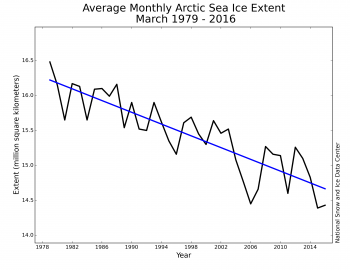http://nsidc.org/arcticseaicenews/
Low Arctic sea ice extent for March caps a highly unusual winter in the Arctic, characterized by persistent warmth in the atmosphere that helped to limit ice growth. Above-average influx of ocean heat from the Atlantic and southerly winds helped to keep ice extent especially low in the Barents and Kara seas. Northern Hemisphere snow cover for both February and March was also unusually low
…
Arctic sea ice extent averaged for March 2016 was the second lowest in the satellite record. Through 2016, the linear rate of decline for March extent is 2.7 percent per decade, or a decline of 42,100 square kilometers (16,200 square miles) per year.
http://nsidc.org/arcticseaicenews/files/2016/04/Figure31-350×270.png
